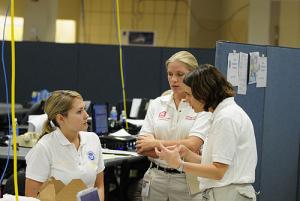In a recent article about increasing worker productivity, McKinsey consultants Eric Matson and Laurence Prusak discuss five types of barriers to knowledge-worker productivity. As knowledge workers, engineers often encounter examples of such barriers. By recognizing them and implementing practices to reduce their impact, companies can not only increase the productivity of their engineering work force but also increase job satisfaction and retention. Let's discuss each of these five types of barriers and ways to remove them.
Don't forget to vote for the barrier that frustrates you the most at the end of this article.
Physical

Eric and Laurence claim that over half the time spent by productivity workers is in interactions. While the actual proportion may vary depending on the role and group that an engineer belongs to (e.g. operations, research, projects, etc.), interactions are definitely a key part of an engineer's time at work. With the advent of globalization and outsourcing, most engineers have to interact with people not physically accessible in the same location.
The negative effects of physical separation are sometimes compounded by different time zones. Investing in reliable and easy to use conferencing and communication tools is essential for minimizing the impact of physical and time zone differences. An emerging practice to address physical separation barriers among team members is creation of "communities of practice". Using collaboration software such as wikis, communities of practice allow engineers with common roles to share ideas, tips, and tools to enhance each other's productivity.
Technical
The two most common examples of technical barriers to engineering productivity are a lack of proper tools (usually software) and lack of easy access to required data. Poor data collection and reporting systems cause engineers to waste hours of high value time on such frustrating tasks as copying and pasting information from one system to another before they can conduct their engineering analysis. By providing access to the right software tools, companies can not only increase productivity but also reduce frustration and job dissatisfaction among engineers.
In addition to proper technical tools, engineers also need robust information systems that provide easy access to data required for their role. Poorly organized information systems and work flows can result in wasted time by engineers while they spend time gathering data from multiple sources. Addressing information availability does not always require an investment in new information technology, it can be done by assessing work flows and existing databases to ensure that the information is available at the right time to the right person.
Social
Rigid hierarchies and functional silos are examples of social barriers that reduce engineering effectiveness. Delays while waiting for approvals from management can slow down engineer productivity as well as limit the sharing of new ideas from the junior team members. In globalized teams, cultural norms (Eastern vs. Western) can hinder free sharing of ideas and initiatives also.
To address the social and cultural barriers, empowerment of decision making must be delegated down to the lowest practical level. Examples of how junior member contribution delivered success in a team should be celebrated. Cross-functional communication should be encouraged. An innovative idea practices by some leading companies is mixing members of various functions (design engineering, production, research, etc.) in a common office location instead of isolating them by functions.
Contextual

Contextual barriers arise when hyper-specialized engineers are unable to understand and respond to influences and conditions from outside their immediate role and function. For example, in some companies, engineers in production roles tend to misunderstand and perhaps even distrust the goals and motives of employees in commercial roles such as purchasing, finance, and marketing. If engineers cannot align their own work and goals with the work and goals of other functions, the overall result for the organization can be negative.
In other words, poor contextual understanding between the parts can result in a sum that is less. One common solution to eliminating contextual barriers is rotation programs for new hires as well as executives. Co-location of engineers with members from other functions in one office area can help increase contextual awareness of engineers by providing opportunities for informal interaction.
Time
The last barrier discussed by Eric and Laurence is the lack of time to share and disseminate knowledge among teams and from experienced to newer members. If the experienced team members are overloaded with their assignments, they do not have time to teach, explain, and share their lessons learned to other members of their work groups. By having everyone focus just on getting as much direct work done as possible, the indirect work required to increase long term capability and productivity of work groups is neglected.
Companies can address this barrier by chartering centers of excellence staffed by a few key individuals who act as knowledge intermediaries. The engineers who are placed in these centers can monitor the people and processes to identify good ideas and practices that should be replicated across the organization through training and work process changes.
Can you share examples of how you addressed one of these barriers in your career?
Are there additional types of barriers unique to the chemical engineering profession?



Comments
One additional thing on the technical side is older or outdated equipment. I find myself spending more time than necessary waiting for my computer to load files or start-up software.
Yes, thank you for pointing this out. I have even heard extreme cases of companies still using DOS based software as recently as couple of years ago. The value of lost time is much higher than any savings from delaying the upgrade.
As an employee of the public sector, state government, I find that physical, technical, and time barriers abound. All of the data that I review is collected by a third party working in the private sector, and I do not have the time to be on-site when the data is collected. If I had the time to be on-site during the data collection, I could make decisions in real time. The technical barriers include a lack of state-of-the-art software and a lack of continuing education. Federal agencies and laboratories do some wonderful research, yet I rarely get the benefit of their findings.
Trent, May I ask if you in a regulatory agency? It sounds like the recent boom in wireless data collection and real time reporting using smart phones could be a productivity enhancer for you. Perhaps an entrepreneur can create an "app for that". Of course, this is assuming that iPhones will be allowed and supported at your organization soon. I am very enthusiastic about the hype around how tablets like iPad will enable real-time data gathering and sharing.
Another one to consider is knowledge transfer. Much productivity is lost when people are consistently trying to "reinvent the wheel" because insufficient transition or lack of supporting documentation.
Hi May, I would add to your point that the knowledge transfer challenge can be made worse by the presence of other barriers. The same wheel can keep getting reinvented in different locations and functions of the same company if the documentation systems are not there as you mention. Thanks, Adnan
I second May's opinion that knowledge transfer is a massive productivity vacuum. It seems to pull together many of the above barriers into one, which makes me wonder if a little thought might enable us to be clever about implementing solutions to the above problems. For example - the effective use of a wiki might be capable of addressing the physical barrier of location, the technical barrier of data amalgamation and the social barrier of cross-functional collaboration all at the same time. Of course we may have to accept a deficit on time to set it up, but perhaps the pay-off is worthwhile?
I think "culture" of some organizations encompasses all these barriers at varied proportions. Now fighting that 'cultural barrier' is a challenge.